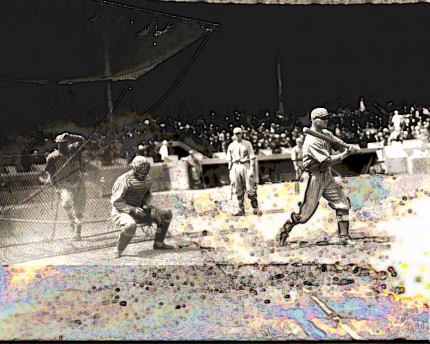The national anthem's sports connection
During the 2016 season, NFL quarterback Colin Kaepernick began to sit or take a knee as the anthem was played to protest police brutality against African-Americans. He, along with other players who did the same, faced criticism. This season, President Donald Trump inserted himself into the controversy with Twitter taunts critical of the players and the league.
The NFL’s commissioner, Roger Goodell, has said he would like players to stand for the anthem. But today he also said that the league did not ask for changes on the anthem policy. (See the story on ESPN’s website.)
In response, Trump tweeted, “The NFL has decided that it will not force players to stand for the playing of our National Anthem. Total disrespect for our great country!”
But when did the anthem become such an integral part of athletic events? For the answer, we turn to another sport -- baseball. Next year marks the 100th season since "The Star-Spangled Banner" became part of the World Series. Here is how it happened, along with links for further study.
About the song: Francis Scott Key’s famous lyrics were written after Baltimore’s Fort McHenry withstood a British attack in the War of 1812. But there’s more to it than meets the eye. Key included a verse (that no one ever sings) about the “hireling and slave,” a reference to African-Americans recruited for a British Navy unit formed just for them and called the Colonial Marines. (See our story: Francis Scott Key, land of the free and slavery.)
When did it become the national anthem? President Woodrow Wilson ordered that "The Star-Spangled Banner" be played at military and naval occasions in 1916, according to the U.S. Army’s website. But Congress didn’t designate it as the national anthem until 1931.
Why is it played during sporting events? The song was played at various games beginning in 1862, according to a Chicago Tribune account. But the tradition began in earnest with the World Series of 1918.Emotional events set the stage. On Sept. 4, 1918, a bomb was tossed into the Adams Street entrance of the Chicago federal building and post office, according to the Smithsonian National Postal Museum’s website. Four people, including two postal workers, were killed. The police investigated, focusing on a labor union. While arrests were made, there were no convictions. Dozens of others were injured.
Beyond that, the country was caught up in World War I, and families were losing loved ones. Against this backdrop, the World Series began Sept. 5 at Chicago's Comiskey Park, with the Chicago Cubs squaring off against the Boston Red Sox.
This is how it was reported in The New York Times the next day: “As the crowd of 19,274 spectators -- the smallest that has witnessed the diamond classic in many years -- stood up to take their afternoon yawn, …. the band broke forth to the strains of The Star-Spangled Banner.
“The yawn was checked and heads were bared as the ball players turned quickly about and faced the music."
Fred Thomas, a Red Sox infielder on furlough from the Navy "was at attention and he stood erect with his eyes set on the flag fluttering at the top of the lofty pole in right field," the Times reported. "First the song was taken up by a few, then others joined, and when the final notes came, a great volume of melody rolled across the field. It was at the very end that the onlookers exploded into thunderous applause and rent the air with a cheer that marked the highest point of the day’s enthusiasm.”
The performance -- by a military band – had come during the seventh inning of the game. (Read the 2011 story on ESPN’s website, The Song Remains the Same, by Luke Cyphers and Ethan Trex.).
The anthem was played in the next two games during the seventh inning. When the series moved to Boston -- where the Red Sox were ultimately victorious -- "The Star-Spangled Banner" was played during the pregame ceremonies with more fanfare, including the introduction of wounded soldiers, according to the ESPN account.
The song becomes an institution: After that," The Star-Spangled Banner" was played at World Series and holiday games and eventually at other games, the ESPN account reports.
To know more:
- Chicago Tribune: 1918 World Series started the U.S. love affair with national anthem.
- ESPN: The Song Remains the Same, by Luke Cyphers and Ethan Trex, Sept. 8, 2011.
- ESPN: Roger Goodell didn't ask players, owners to change national anthem policy, Oct. 18, 2017.
- The New York Times: Red Sox beat Cubs in Initial Battle of World's Series, Sept. 6, 1918.
- StudyHall.Rocks: Francis Scott Key, land of the free and slavery
- Smithsonian National Postal Museum: Chicago Bombs, 1918.
- U.S. Army website: The U.S. National Anthem.
Related:
Sports: A history rich in scandal
If you would like to comment, like us on Facebook and tell us what you think.


